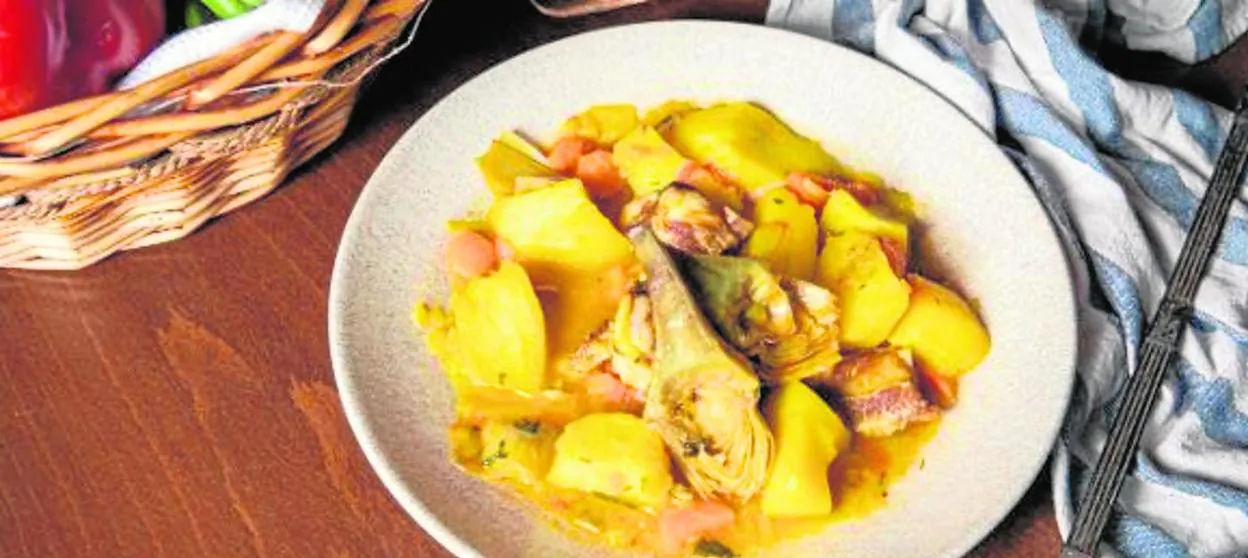Cazuela, a spoonful of spring flavours
A family of fish and meat stews with a rich history spanning centuries and cultures, leading to the richness of local Malaga cuisine
ESPERANZA PELÁEZ
MALAGA.
Friday, 1 April 2022, 12:01
There are few forgotten, local Malaga dishes quite like cazuelas (similar to casseroles). While ajoblancos (chilled garlic and almond soup), porras (a thicker version of gazpacho) or gazpachuelos (a local fish soup with mayonnaise, garlic, egg yolk and olive oil) have been star dishes on restaurant menus, cazuelas are starting to make their way onto the menus of restaurants, ventas (pubs) and, though less often, at home, where its true place used to be.
Guillermo Rosselló Bordoy, an archaeologist specialising in Moorish tools, writes that the word 'cazuela' is a diminutive of the word 'qas'a', one of the most important utensils used in medieval Arab cooking. Cazuelas, ceramic with either a flat or convex base and shallower than cooking pots, were used for both broths and stews.
The utensil has a long history, but it's hard to pinpoint the origin of this dish. In Al-Andalus cookbooks there are some recipes that mix vegetables with meat, various greens and seasoned with saffron and vinegar. But these are very different from cazuelas.
Sephardic Jews, in medieval times, used a lot of olive oil in their sofritos (gently fried onions and garlic) to enrich their dishes. Similar to the Moors, the Sephardi cooked noodles in broths, but this wasn't close to cazuelas either.
"A cazuela is the union of a soup or broth with a sofrito," explained historian Fernando Rueda, who states that "sofritos didn't become the norm in Spanish cooking until the 18th century". Rueda points to Antonio Salsete, a gourmand from Navarre who lived between the 17th and 18th centuries, as one of the first people to give a dish the name cazuela. But the tomato cazuela he names in one of his cookbooks has little to do with the local Malaga cazuelas. It's more akin to an onion stir-fry with seasoned tomatoes and breadcrumbs.
"It's hard to trace traditional cooking, because it's a type of cuisine that isn't documented when it's created," said Fernando Rueda. "Generally, cazuelas do have a sofrito base, an affordable protein, (meat or fish), and a source of carbohydrate: noodles, rice, potatoes; and some vegetables."
Fernando Rueda also says that in Malaga, the coast is where these dishes have a higher diversification and evolution. Seafood cazuelas are made with fish and shellfish, which were cheap back in the day: cod, clams, prawns, mussels, squid, monkfish...
Meat cazuelas are also varied. If pork is used, ribs are the usual choice. If it's game, either rabbit, partridge, and more recently, chicken.
Cazuelas are generally served with seasonal vegetables, particularly beans, artichokes, pumpkins and peas. Wild asparagus is used when available during the rainy season. In terms of spices, cazuelas made in the province's inland region are dominated by cumin, cloves and pepper.
On the coast it's cumin, mint and saffron. "Saffron is a very expensive spice, so it's not used often. But at the start of the 20th century, with the invention of yellow food colouring, yellow-coloured stews became the norm," said Fernando Rueda.
Origins
Is the cazuela exclusively a local, Malaga dish? Well, no. As with any traditional cooking invention, versions of cazuelas exist in different places. On the Granada coast they make a noodle cazuela. Catalan and Levante 'suquets' are seafood cazuelas. In Almeria, it's common to see stews with different types of pastas, also seen in Jaén or Murcia. "Noodles in the inland regions are stewed with rabbit, but on the coast they're cooked with fish," said Fernando Rueda.
Cazuelas are a recent addition to Malaga's cuisine. A 1867 cookbook by Guillermo Moyano includes two cazuela recipes, one with cod and another with hake. Both are fish stews with a sofrito base and a flour-thickened sauce.
Enrique Mapelli (1921-2018), a pioneer in the documentation of traditional Malaga cooking, told journalist Fernando Sánchez that his favourite dish was a noodle cazuela. In his 1992 book 'Malaga gastronomy recipes', he includes nine recipes labelled as cazuelas.
Even if cazuelas aren't exclusive to Malaga, we cannot allow them to disappear from its menus, as they have proven to be a part of the province's culinary history that should be preserved.
